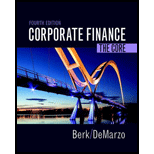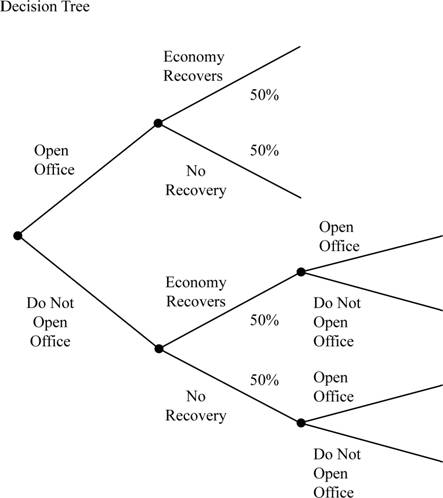
Your company is planning on opening an office in Japan. Profits depend on how fast the economy in Japan recovers from its current recession. There is a 50% chance of recovery this year. You are trying to decide whether to open the office now or in a year. Construct the decision tree that shows the choices you have to open the office either today or one year from now.
To draw: The decision tree.
Introduction:
Decision tree is a tree-like graph which helps to identify strategies which are most likely to achieve goals. A decision tree comprises decision support tools.
Explanation of Solution
Given information:
A company is planning on opening an office in Japan. Company profit depends on Japanʼs economyʼs recovery from its current recession. The chance of recovery from recession is 50.00%.
Possible decision:
Possible decision in the decision tree:
- 1. To open office
- 2. To not open office
If to open office, then two possible decisions:
- 1. Economy recover
- 2. Economy doesn’t recover
If to not open office, then two possible decisions:
- 1. Economy recover
- 2. Economy doesn’t recover
If to not open office and economy recover, then two possible decisions:
- 1. To open office
- 2. To not open office
If to not open office and the economy does not recover, then two possible decisions:
- 1. To open office
- 2. To not open office
Diagram from decision tree:

Want to see more full solutions like this?
Chapter 22 Solutions
Corporate Finance: The Core (4th Edition) (Berk, DeMarzo & Harford, The Corporate Finance Series)
Additional Business Textbook Solutions
Managerial Accounting (5th Edition)
Principles Of Taxation For Business And Investment Planning 2020 Edition
Financial Accounting: Tools for Business Decision Making, 8th Edition
Operations Management
Accounting For Governmental & Nonprofit Entities
Horngren's Cost Accounting: A Managerial Emphasis (16th Edition)
- TIME TO REACH A FINANCIAL GOAL You have $42,180.53 in a brokerage account, and you plan to deposit an additional $5,000 at the end of every future year until your account totals $250,000. You expect to earn 12% annually on the account. How many years will it take to reach your goal? Round UP to the nearest year. (Example 5.01 years = 6 years) Your answer should include numerical value only.arrow_forwardYou plan to retire in 30 years. • In 50 years, you want to give your daughter a $500,000 gift. • You will receive an inheritance of $200,000 in 25 years. • You think you will want $50,000 per year when you retire for 30 years (the first withdrawal will come one year after retirement). • You will begin saving an amount to meet your retirement goals one year from today. Required: • If you think you can make 9% on your investments, how much will you need to save each year for the next 30 years to meet your retirement goals?arrow_forwardAn initial $3300 investment was worth $3820 after two years and six months. What quarterly compounded nominal rate of return did the investment earn? (Do not round intermediate calculations and round your final answer to 2 decimal places.) Nominal rate of return % compounded quarterly.arrow_forward
- Suppose your firm is considering investing in a project with the cash flows shown below, that the required rate of return on projects of this risk class is 9 percent, and that the maximum allowable payback and discounted payback statistics for the project are 2.0 and 3.0 years, respectively.arrow_forwardPlease don't use Ai solutionarrow_forwardng Equipment is worth $998,454. It is expected to produce regular cash flows of $78,377 per year for 20 years and a special cash flow of $34,800 in 20 years. The cost of capital is X percent per year and the first regular cash flow will be produced in 1 year. What is X? Input instructions: Input your answer as the number that appears before the percentage sign. For example, enter 9.86 for 9.86% (do not enter .0986 or 9.86%). Round your answer to at least 2 decimal places. percentarrow_forward
- 3 years ago, you invested $6,700. In 5 years, you expect to have $12,201. If you expect to earn the same annual return after 5 years from today as the annual return implied from the past and expected values given in the problem, then in how many years from today do you expect to have $25,254?arrow_forward4 years ago, you invested $3,600. In 2 years, you expect to have $7,201. If you expect to earn the same annual return after 2 years from today as the annual return implied from the past and expected values given in the problem, then in how many years from today do you expect to have $10,022? Input instructions: Round your answer to at least 2 decimal places. yearsarrow_forwardSince ROE can sometimes be boosted artificially through financial leverage, do you think it would be more beneficial for investors to rely on a combination of ROE and other financial health indicators, such as the debt-to-equity ratio or interest coverage ratio, when assessing a stock's long-term potential?arrow_forward
- Given that Merck and Pfizer both face revenue risks from patent expirations, how do you think financial managers at these companies should adjust their capital structure to maintain stability and investor confidence?arrow_forwardDon't used hand raiting and don't used Ai solutionarrow_forwardJohn works for a fixed income hedge fund. Your fund invests in $100 million in mortgage-backed-bonds (MBS) with a duration of 10. He finances these bonds with $2 million in investor capital and $98 million of overnight repurchase agreements (required haircut=2%) with an interest rate of 1%. After hours, negative news comes out on the evening news that increases yields on MBS by 25 basis points. Moreover, effective tomorrow, because of this bad news, repurchase agreement lenders will now require a haircut of 3% to lend to you via repurchase agreements with your MBS as collateral. Assuming he receives no interest payments from your MBS, how much cash does he need to not default on today’s repurchase agreement and to keep the position open for one more day tomorrow? Please provide calculations in excel.arrow_forward
- Principles of Accounting Volume 2AccountingISBN:9781947172609Author:OpenStaxPublisher:OpenStax College
 Cornerstones of Cost Management (Cornerstones Ser...AccountingISBN:9781305970663Author:Don R. Hansen, Maryanne M. MowenPublisher:Cengage Learning
Cornerstones of Cost Management (Cornerstones Ser...AccountingISBN:9781305970663Author:Don R. Hansen, Maryanne M. MowenPublisher:Cengage Learning

